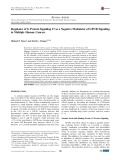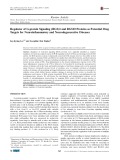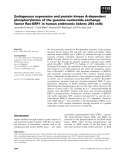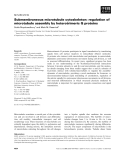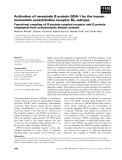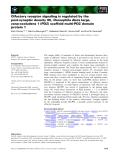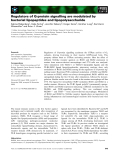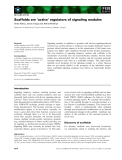
Regulator of G protein signaling
-
Regulators of G protein signaling (RGS) proteins modulate G protein-coupled receptor (GPCR) signaling networks by terminating signals produced by active Gα subunits. RGS17, a member of the RZ subfamily of RGS proteins, is typically only expressed in appreciable amounts in the human central nervous system, but previous works have shown that RGS17 expression is selectively upregulated in a number of malignancies, including lung, breast, prostate, and hepatocellular carcinoma.
 10p
10p  caothientrangnguyen
caothientrangnguyen
 09-05-2020
09-05-2020
 13
13
 1
1
 Download
Download
-
Regulator of G-protein signaling (RGS) proteins were originally identified as negative regulators of G-protein-coupled receptor (GPCR) signaling via their GTPase-accelerating protein (GAP) activity. All RGS proteins contain evolutionarily conserved RGS domain; however, they differ in their size and regulatory domains. RGS1 and RGS10 are smaller than other RGS proteins, and their functions involve various inflammatory responses including autoimmune responses in both the periphery and the central nervous system (CNS). Neuroinflammation is the chronic inflammatory response in the CNS.
 5p
5p  caothientrangnguyen
caothientrangnguyen
 09-05-2020
09-05-2020
 30
30
 2
2
 Download
Download
-
Regulator of G protein signaling (RGS) proteins are gatekeepers regulating the cellular responses induced by G protein-coupled receptor (GPCR)-mediated activation of heterotrimeric G proteins. Specifically, RGS proteins determine the magnitude and duration of GPCR signaling by acting as a GTPase-activating protein for Gα subunits, an activity facilitated by their semiconserved RGS domain. The R7 subfamily of RGS proteins is distinguished by two unique domains, DEP/DHEX and GGL, which mediate membrane targeting and stability of these proteins.
 13p
13p  caothientrangnguyen
caothientrangnguyen
 09-05-2020
09-05-2020
 30
30
 1
1
 Download
Download
-
We have previously reported the Ras-dependent activation of the mitogen-activated protein kinases p44 and p42, also termed extracellular signal-regulated kinases (ERK)1 and 2 (ERK1⁄2), mediated through Gs-coupled serotonin receptors transiently expressed in human embryonic kidney (HEK) 293 cells. Whereas G i- and Gq-coupled receptors have been shown to activate Ras through the guanine nucleotide exchange factor (GEF) called Ras-GRF1 (CDC25 Mm ) by binding of Ca 2+ ⁄calmodulin to its N-terminal IQ domain, ...
 0p
0p  awards
awards
 06-04-2013
06-04-2013
 37
37
 3
3
 Download
Download
-
Regulator of G protein signaling (RGS) proteins act as GTPase-activating proteins (GAPs) for Gasubunits and negatively regulate G protein-coupled receptor signaling. Using RGS5 gene-specific RT-PCR, we have identified a novel alternative splicing variant of RGS5 mRNA in human ocular tissues. The alternative splicing of RGS5 mRNA occurred at position +44 (GenBank NM_003617), spliced out 174 bp (+44 to +218 bp) of the cod-ing region, and encoded an RGS5s protein with a 108 amino acid N-ter-minal deletion. ...
 0p
0p  awards
awards
 05-04-2013
05-04-2013
 37
37
 2
2
 Download
Download
-
Accumulating evidence indicates that G protein signaling plays an active role in the regulation of cell survival. Our previous study demonstrated the regulatory effects of Gi⁄ o proteins in nerve growth factor-induced activa-tion of pro-survival Akt kinase. In the present study we explored the role of various members of the Gs,Gq⁄ 11 and G12⁄ 13 subfamilies in the regula-tion of Akt in cultured mammalian cells.
 11p
11p  inspiron33
inspiron33
 26-03-2013
26-03-2013
 48
48
 4
4
 Download
Download
-
Heterotrimeric G proteins participate in signal transduction by transferring signals from cell surface receptors to intracellular effector molecules. G proteins also interact with microtubules and participate in microtubule-dependent centrosome⁄chromosome movement during cell division, as well as neuronal differentiation.
 10p
10p  inspiron33
inspiron33
 23-03-2013
23-03-2013
 36
36
 5
5
 Download
Download
-
Signal transduction mediated by heterotrimeric G proteins regulates a wide variety of physiological functions. We are interested in the manipulation of G-protein-mediating signal transduction using G-protein-coupled receptors, which are derived from evolutionarily distant organisms and recognize unique ligands.
 9p
9p  inspiron33
inspiron33
 23-03-2013
23-03-2013
 51
51
 5
5
 Download
Download
-
The voltage-gated potassium channel Kv4.3 was coexpressed with itsb-sub-unit Kv channel-interacting protein 2 and the angiotensin type 1 receptor in HEK-293 cells. Proteomic analysis of proteins coimmunoprecipitated with Kv4.3 revealed that Kv4.3 is associated with Rap guanine nucleotide exchange factors MR-GEF and EPAC-1.
 10p
10p  media19
media19
 04-03-2013
04-03-2013
 38
38
 2
2
 Download
Download
-
The unique ability of mammals to detect and discriminate between thou-sands of different odorant molecules is governed by the diverse array of olfactory receptors expressed by olfactory sensory neurons in the nasal epithelium. Olfactory receptors consist of seven transmembrane domain G protein-coupled receptors and comprise the largest gene superfamily in the mammalian genome.
 12p
12p  vinaphone15
vinaphone15
 27-02-2013
27-02-2013
 48
48
 4
4
 Download
Download
-
Regulators of G-protein signalling accelerate the GTPase activity of Ga subunits, driving G proteins in their inactive GDP-bound form. This property defines them as GTPase activating proteins.
 11p
11p  vinaphone15
vinaphone15
 27-02-2013
27-02-2013
 31
31
 3
3
 Download
Download
-
Signaling cascades, in addition to proteins with obvious signaling-relevant activities (e.g. protein kinases or receptors), also employ dedicated ‘inactive’ proteins whose functions appear to be the organization of the former com-ponents into higher order complexes through protein–protein interactions. The core function of signaling adaptors, anchors and scaffolds is the recruitment of proteins into one macromolecular complex.
 7p
7p  viettel02
viettel02
 19-02-2013
19-02-2013
 41
41
 1
1
 Download
Download
-
Src family kinases (SFKs) play critical roles in the regulation of many cellular functions by growth factors, G-protein-coupled receptors and ligand-gated ion channels. Recent data have shown that SFKs serve as a convergent point of multiple signaling pathways regulating N-methyl-D-aspartate (NMDA) receptors in the central nervous system.
 9p
9p  cosis54
cosis54
 08-12-2012
08-12-2012
 34
34
 2
2
 Download
Download
CHỦ ĐỀ BẠN MUỐN TÌM








